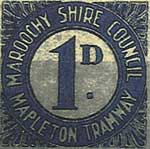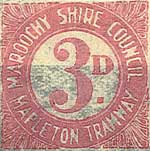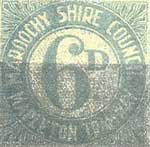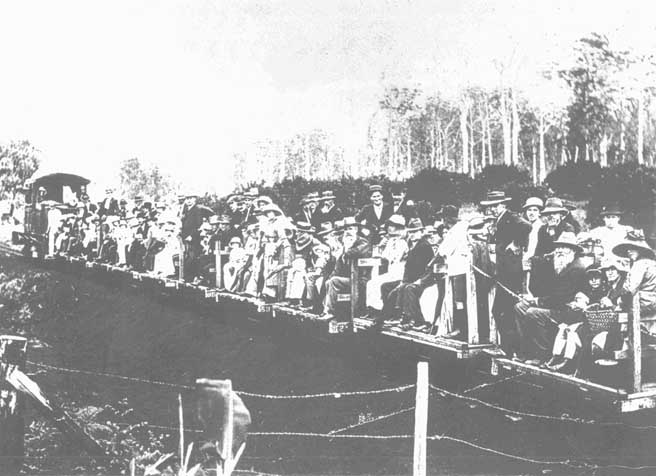


Whistles in the hills
The
station at Mapleton was located adjoining the western part of the Mapleton State
School reserve, opposite the Mapleton Public Hall. An engine shed was provided
there to house the Mapleton locomotive.
Water was pumped from a well at the nearby creek into a rectangular steel tank
on tall piers for the use of the engines. A short spur line ran up to the
general store opposite the hotel.
Trains
would arrive at the station and unload passengers and goods. Then, if
necessary, they would set back up to the end of the spur, stopping between the
general store and the hotel, where goods ordered by those establishments would
be unloaded.
The Mapleton
generally operated the regular Mapleton Tram, while the Dulong
operated on the Perwillowen, Burnside and Image Flat lines, carrying cane
and logs. The Dulong was housed in a
small, open engine shed at Nambour. Occasionally the two locos swapped jobs.
The
locomotives always travelled with their chimney end facing Mapleton, as the
steepest descents were encountered on the down trip. To descend
to Nambour chimney first would cause the water in the boiler to incline to the
front on the steepest parts of the line (just below Mapleton and Doig's
Point), leading to the danger of the hot crown of the fire-box being uncovered.
If this were to happen, the lead fusible plugs in the firebox would melt,
releasing steam onto the fire and putting it out as a safety measure.
This
would render the locomotive inoperable, so they came up the Range chimney first,
and returned to Nambour bunker first. In any case, there was no triangle (wye)
nor turntable at either Mapleton or Nambour, so there was no facility for
turning the locomotives or carriages around. The downhill gradients when
travelling to Mapleton (Doig's and Christie's Banks) were only 1 in 33, not
steep enough to cause water problems when the locomotives travelled down these
banks chimney first.
Despite low profitability in the beginning, the Mapleton Tramway ran more-or-less successfully for twenty-nine years. The management and Shire Council were satisfied if its income was enough to cover costs - it was never seen as a profit-making operation. The service to Nambour, eleven miles away by train (seventeen kilometres), was operated to a regular timetable. The tram left Mapleton at 9.00 a.m. on Mondays, Wednesdays and Fridays, arriving in Nambour at approximately 10.30 a.m.



Freight stamps for the Mapleton Tramway - one penny, threepence, and sixpence
On
Tuesdays and Thursdays and the tram left earlier at 7.00 a.m., enabling it to reach
Nambour by 8.30 a.m., where it would connect with the 9.00 a.m. 'up' train
to Brisbane. The tram would wait at Nambour until the 11.30 a.m. 'down'
train from Brisbane arrived, and take on board any passengers and freight. It
would depart from Nambour at 12.30 p.m. on the return trip to Mapleton, arriving
at its destination at 2.45 p.m. A Saturday service was also run, probably on the
Thursday schedule, but the actual timetable is not known with certainty. The regular tram did not operate on Sundays, that day
being set aside for locomotive servicing and maintenance, and the occasional
excursions.
The
trip took about one and three-quarter hours to climb up the Range, and one and a
half hours to go down. The train carried logs, sawn timber, cream, pigs, calves,
cattle, fruit, maize, sugar cane, cases of oranges and mandarins, and other
produce down the Range. Timber was hauled up from the Obi Obi valley by horse
teams, and then transferred to rail at the Mapleton Tramway Station.
From
Nambour, the tram brought up mail, orders from grocers, butchers and bakers, ice
for ice chests and fertiliser for farmers. There were special carriages for
passengers, the one-way fare in 1923 being 2/-. By 1943 the single fare had
risen to only 2/6, and the trams ran at the same time every day except Sunday.
The
tram also operated a co-ordinated service with the North Coast Railway for an
excursion from Brisbane once a month. Sometimes up to 250 people would make the
train journey to Nambour and then transfer to the tram for a trip up the Range
to spend three hours at Mapleton.
Local
legend has it that, as the
tram wound its way laboriously up the grades at a walking pace, daring
passengers had plenty of opportunity to jump off, make sorties into the nearby
sugar cane fields or orchards in search of a piece of cane to chew or free
fruit, and then leap back on board again. On such days, orchardists with fruit
trees beside the tramway had to guard their crops. One farmer put up an
impressive sign: "With God's help I grew these oranges. God help you if you
touch them."
When
they arrived at their destination, passengers could travel by local transport to
the Mapleton Falls and other vantage points along the Range, to enjoy the scenic
beauty and grandeur of the district. Orchards around the town and on the way to
the Falls were also raided by hungry tourists. Visitors
could also walk up past the
hotel to 'The Front', to admire the views down the valleys to the Pacific
Ocean. At Mapleton, school children made pocket money by selling staghorns,
ferns and similar plants from the forest to the tourists. Prices tended to fall
as the tram's departure time approached, and late-buying tourists found that
they could purchase staghorns and elkhorns for 3d. each.
Shortly
before Christmas each year, the Moreton Central Mill would organise a 'Harvest
Home' picnic to celebrate the end of the crushing. On these occasions, a cane
train would convey mill staff and their families to a suitable venue. A
locomotive would have as many as twelve flat cane trucks attached, fitted with
temporary seats so that each truck could accommodate ten people.

Photograph
courtesy Sunshine Coast Libraries
There
is displayed in the Mapleton Tavern a well-known photograph (above) showing one of these excursions, hauled by a Shay, with Mapleton
claimed as the destination. There are over 100 passengers on board, riding on
benches bolted to ten cane trucks. If this
excursion was held after 1915, the Mill would have had
to hire the locomotive from the Shire Council. As the cane
trucks had no brakes (except for some left over from horse-haulage days equipped
with hand brakes), the stopping power of the train depended solely
on the locomotive's steam brake or its own hand brake. In an emergency, the
driver could pull his Johnson bar right back and put on steam to reverse the
rotation of the driving wheels, this being a common practice on early steam
trains with unbraked rolling stock. Bearing these facts in mind, if such excursions were conducted on our
steeply graded lines, then they were decidedly risky to say the least,
especially at a point on the Highworth Range where the line clung to the side of
a deep gorge. That
there were no train runaways with catastrophic results was due more to good luck
than good management.